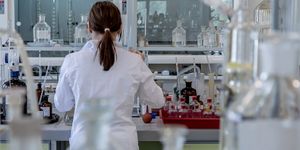A Sea Slug and Algae Rely on a Bacterial Weapons Factory
The inch-long sea slug Elysia rufescens eats algae for sustenance, but it gets an added benefit in the form of toxins within the algae, which can help the slug defend itself. Researchers have found that the toxins are made by bacteria that live in the algae - a newly-identified species that evolved to live in this one place; they cannot survive anywhere else. The bacteria spend at least twenty percent of their energy to create the toxic molecules the slug and algae depend on. This three-way symbiotic relationship has been reported in Science.
"It's a complicated system and a very unique relationship among these three organisms," said the senior author of the report Mohamed Donia, assistant professor of molecular biology at Princeton University. "The implications are big for our understanding of how bacteria, plants, and animals form mechanistic dependencies, where biologically active molecules transcend the original producer and end up reaching and benefitting a network of interacting partners."
The scientists, working at Princeton University and the University of Maryland Center for Environmental Science's Institute of Marine and Environmental Technology used powerful genomic tools to understand the various roles the members of this network are playing. The genetic data from the slugs, algae, and the bacteria that live in them was assessed using computer algorithms that determined which genes belonged to which organism. This information enabled them to identify the bacteria and the toxins they were making.
The bacteria is a species the researchers named Candidatus Endobryopsis kahalalidefaciens, which makes around fifteen different toxins called kahalalides. These natural chemicals are very different from one another, but they can deter fish and other animals. The bacterial genome won’t allow them to live on their own; they’ve taken on many genes to produce these toxins for the algae. The scientists saw them as a type of factory that takes in amino acids and releases these chemicals in turn.
The E. rufescens slug can tolerate the toxins and stores them in a concentrated form like an arsenal. The researchers determined that the slug digests the bacteria and retain the toxic chemicals.
This is not the first symbiotic relationship like this found by the researchers. They’ve also identified a symbiotic bacteria that live in marine sponges and generates toxins that help shield the sponges from predators. Donia said that these types of bacterial symbionts are turning out to be common in the marine environment.
"The weirdest thing is that the sponge has actually evolved a specialized type of cells, which we called 'chemobacteriocytes,' dedicated entirely to housing and maintaining a culture of this bacterium," Donia explained. "This is very strange, given the small number of specialized sponge cells in general. Again, the bacterium cannot produce the substrates and cannot live on its own."
Sources: AAAS/Eurekalert! via Princeton University, Science








